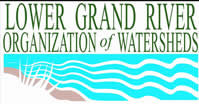Lower Grand Watershed Interactive Tool (WIT) - Nitrogen

Nitrogen is an element that at certain levels can cause excessive algae and aquatic weed growth
Nitrogen? What about it?
Nitrate (a commonly found form of Nitrogen) is a common nutrient found in fertilizer, agricultural runoff, sewage and septic field leachate. Since nitrate exists as a soluble ion, elevated levels in surface water can be related to runoff and groundwater sources.
"Background levels of nitrate in surface water are typically low (less than 1 mg/l). The USEPA safe drinking water standard is 10 mg/l of Nitrate-N. Excess concentrations in streams may lead to algal blooms and eutrophication, conditions which can affect life locally as well as downstream." (1)
Sources of Nitrogen
Nitrogen gas is a naturally occurring compound integral to human and other life on the planet. While representing only a fraction of the total nitrogen found in the environment the incremental levels of nitrogen resulting from human activities can have significant human and ecological health impacts. Since 1970, human activities have doubled the amount of nitrogen entering terrestrial, aquatic, and marine ecosystems. (2)
Natural Sources
"Natural events that generate extreme heat, primarily lightning, combine oxygen and nitrogen to form nitrogen oxide. Nitrogen from the atmosphere is also made available to plants and animals through a process called biological nitrogen fixation. Certain types of algae and bacteria are able to extract nitrogen from the air, making it usable by plants and, ultimately all organisms that eat plants for nourishment& little of the nitrogen from these natural sources moves from one environmental system to another (e.g. from forests to estuaries)." (2)
Man-Made Sources
"The combustion of fossil fuels, in engines used in transportation as well as in electric utility and industrial boilers, accounts for over 90% of the Nitrogen Oxides released in the U.S. due to human activity." Major sources of the Nitrogen Oxides fall into these two categories, large combustion units or transportation-related sources. (2)
Agriculture
Nitrogen compounds added to the terrestrial environment from agricultural source can also impact water and the atmosphere. In most cases, this nitrogen takes the form of ammonia or ammonium.
Farmers added 22 million tons of nutrients to American crops in 1997, more than half of which was nitrogen. This process increases crop productivity, especially as intensive cultivation depletes soil's natural nutrients. It can also cause excess nutrients from these nonpoint sources to wash into streams, rivers, and lakes. In addition, this nitrogen can seep or leach into local groundwater, potentially impacting the quality of drinking water.
Commercial feedlots, often containing large numbers of animals in a small area, also contribute significant quantities of nitrogen to local water supplies. As many animals are confined to a location over time, waste builds up and, if not treated properly, leaches into groundwater or runs off into streams.
"This excess of plant nutrients stimulates rapid growth of photosynthesizing algae and other aquatic plants. The subsequent breakdown of dead algae by aerobic decomposers can deplete the water of dissolved oxygen and can disrupt aquatic systems and reduce aquatic biodiversity." (3)
What Can Nitrogen Do to the Larger Picture?
As numerous streams and rivers contribute their water to larger rivers ( Path from Grand River to Great Lakes to Ocean), lakes, and oceans, the amount of nitrogen increases. When the water from the Grand River reaches the Gulf of Mexico by the Chicago River and Mississippi River the increased of nitrogen and other nutrients contribute to hypoxic, or low-oxygen levels in the Gulf. The low oxygen levels can detrimentally affect aquatic life.
Sources:
(1) J.D. Hem. 1985. Study and interpretation of the chemical characteristics of natural water. US Geological Survey Water-Supply Paper 2254. Washington, DC, USA. 264pp. (2) Nitrogen: Multiple and Regional Impacts. February 2002. EPA Clean Air Market Programs. EPA-430-R-01-006. (3) Miller, G. Tyler Jr. 2000. Living in the Environment 11th edition. Brooks/Cole Publishing Company. pg118. (4) Miller, G. Tyler Jr. 2001. Environmental Science 8th Edition. Brooks/Cole Publishing Company. Canada. pg 309.
